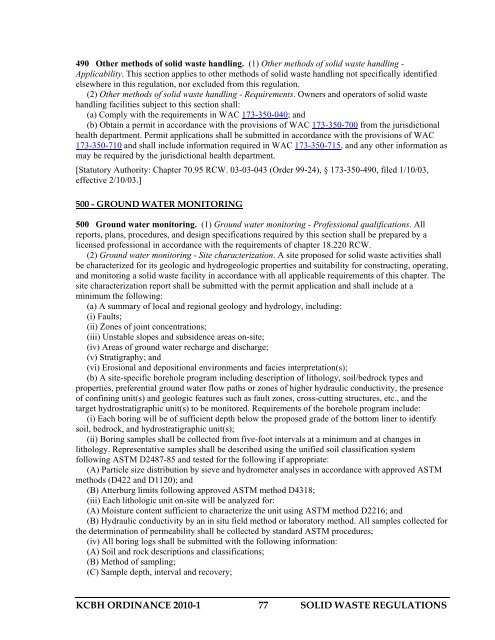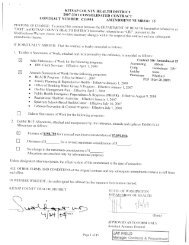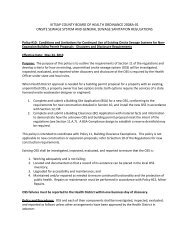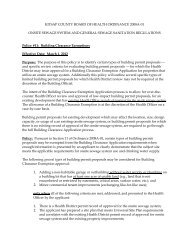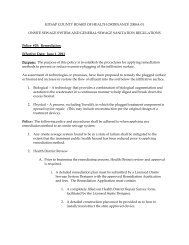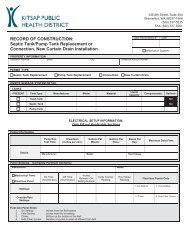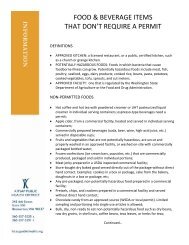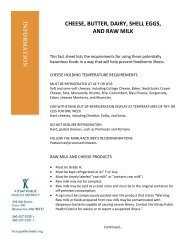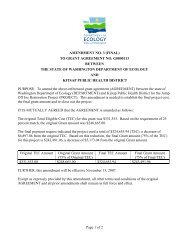SOLID WASTE REGULATIONS - Kitsap Public Health District
SOLID WASTE REGULATIONS - Kitsap Public Health District
SOLID WASTE REGULATIONS - Kitsap Public Health District
Create successful ePaper yourself
Turn your PDF publications into a flip-book with our unique Google optimized e-Paper software.
490 Other methods of solid waste handling. (1) Other methods of solid waste handling -<br />
Applicability. This section applies to other methods of solid waste handling not specifically identified<br />
elsewhere in this regulation, nor excluded from this regulation.<br />
(2) Other methods of solid waste handling - Requirements. Owners and operators of solid waste<br />
handling facilities subject to this section shall:<br />
(a) Comply with the requirements in WAC 173-350-040; and<br />
(b) Obtain a permit in accordance with the provisions of WAC 173-350-700 from the jurisdictional<br />
health department. Permit applications shall be submitted in accordance with the provisions of WAC<br />
173-350-710 and shall include information required in WAC 173-350-715, and any other information as<br />
may be required by the jurisdictional health department.<br />
[Statutory Authority: Chapter 70.95 RCW. 03-03-043 (Order 99-24), § 173-350-490, filed 1/10/03,<br />
effective 2/10/03.]<br />
500 - GROUND WATER MONITORING<br />
500 Ground water monitoring. (1) Ground water monitoring - Professional qualifications. All<br />
reports, plans, procedures, and design specifications required by this section shall be prepared by a<br />
licensed professional in accordance with the requirements of chapter 18.220 RCW.<br />
(2) Ground water monitoring - Site characterization. A site proposed for solid waste activities shall<br />
be characterized for its geologic and hydrogeologic properties and suitability for constructing, operating,<br />
and monitoring a solid waste facility in accordance with all applicable requirements of this chapter. The<br />
site characterization report shall be submitted with the permit application and shall include at a<br />
minimum the following:<br />
(a) A summary of local and regional geology and hydrology, including:<br />
(i) Faults;<br />
(ii) Zones of joint concentrations;<br />
(iii) Unstable slopes and subsidence areas on-site;<br />
(iv) Areas of ground water recharge and discharge;<br />
(v) Stratigraphy; and<br />
(vi) Erosional and depositional environments and facies interpretation(s);<br />
(b) A site-specific borehole program including description of lithology, soil/bedrock types and<br />
properties, preferential ground water flow paths or zones of higher hydraulic conductivity, the presence<br />
of confining unit(s) and geologic features such as fault zones, cross-cutting structures, etc., and the<br />
target hydrostratigraphic unit(s) to be monitored. Requirements of the borehole program include:<br />
(i) Each boring will be of sufficient depth below the proposed grade of the bottom liner to identify<br />
soil, bedrock, and hydrostratigraphic unit(s);<br />
(ii) Boring samples shall be collected from five-foot intervals at a minimum and at changes in<br />
lithology. Representative samples shall be described using the unified soil classification system<br />
following ASTM D2487-85 and tested for the following if appropriate:<br />
(A) Particle size distribution by sieve and hydrometer analyses in accordance with approved ASTM<br />
methods (D422 and D1120); and<br />
(B) Atterburg limits following approved ASTM method D4318;<br />
(iii) Each lithologic unit on-site will be analyzed for:<br />
(A) Moisture content sufficient to characterize the unit using ASTM method D2216; and<br />
(B) Hydraulic conductivity by an in situ field method or laboratory method. All samples collected for<br />
the determination of permeability shall be collected by standard ASTM procedures;<br />
(iv) All boring logs shall be submitted with the following information:<br />
(A) Soil and rock descriptions and classifications;<br />
(B) Method of sampling;<br />
(C) Sample depth, interval and recovery;<br />
KCBH ORDINANCE 2010-1 77 <strong>SOLID</strong> <strong>WASTE</strong> <strong>REGULATIONS</strong>


